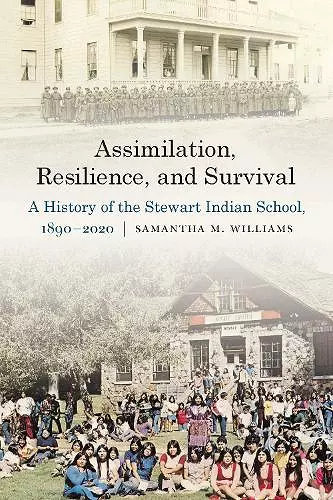Assimilation, Resilience, and Survival
A History of the Stewart Indian School, 1890–2020
Format:Hardback
Publisher:University of Nebraska Press
Published:1st May '22
Currently unavailable, and unfortunately no date known when it will be back

Assimilation, Resilience, and Survival illustrates how settler colonialism propelled U.S. government programs designed to assimilate generations of Native children at the Stewart Indian School (1890–1980). The school opened in Carson City, Nevada, in 1890 and embraced its mission to destroy the connections between Native children and their lands, isolate them from their families, and divorce them from their cultures and traditions. Newly enrolled students were separated from their families, had their appearances altered, and were forced to speak only English. However, as Samantha M. Williams uncovers, numerous Indigenous students and their families subverted school rules, and tensions arose between federal officials and the local authorities charged with implementing boarding school policies.
The first book on the history of the Stewart Indian School, Assimilation, Resilience, and Survival reveals the experiences of generations of Stewart School alumni and their families, often in their own words. Williams demonstrates how Indigenous experiences at the school changed over time and connects these changes with Native American activism and variations in federal policy. Williams’s research uncovers numerous instances of abuse at Stewart, and Assimilation, Resilience, and Survival addresses both the trauma of the boarding school experience and the resilience of generations of students who persevered there under the most challenging of circumstances.
"Williams's book is a valuable contribution to the burgeoning field of federal boarding schools. She demonstrates a clear mastery of the insights and methodologies of the field to date, while her own use of their methodologies suggests some important ways in which the field might develop in the future—especially as scholars continue to learn how to produce scholarship that benefits boarding school alumni, their families, and their communities."—John R. Gram, Western Historical Quarterly
"With this increased attention, more people—inside and outside academia—are compelled to educate themselves on this crucial part of American history. Samantha M. Williams has provided a rigorous book that is accessible to a wide range of readers."—José F. Gutiérrez, California History
"Williams' text is a great contribution to the field of boarding school history and may serve as a model to other researchers on how to integrate oral traditions and archival materials while centering community narratives."—Angel M. Hinzo, American Indian Culture and Research Journal
"Williams's book is important for the nuance and detail it brings to understandings of an American boarding school system that was part of a wider process of settler colonialism."—Martha Walls, Journal of the History of Childhood and Youth
“Samantha Williams’s history of the Stewart Indian School is part of a new generation of research that brings laser focus to particular boarding schools and foregrounds their meaning to the students who attended them. . . . Williams also tells the significant story of Indigenous activists who fought to preserve Stewart’s buildings as a museum so this painful history will not be erased.”—Margaret Jacobs, author of A Generation Removed: The Fostering and Adoption of Indigenous Children in the Postwar World
“Samantha Williams has done an outstanding job of bringing to life the stories and experiences of the students who attended Stewart Indian School. This book is an important teaching tool to share the little-known history of U.S. boarding schools.”—Bobbi Rahder, museum director of the Stewart Indian School Cultural Center & Museum
“As we begin to more fully reckon with the history of the boarding schools and their legacy in the present, this outstanding book needs to be on everyone’s reading list. Williams provides a superbly written and extensively researched examination of the Stewart Indian School that centers Indigenous children’s experiences at the school throughout its nearly one-hundred-year history. The book, a sweeping and powerful study of a lesser-known boarding school, makes a significant contribution to the scholarship on Nevada Indigenous history and to broader conversations regarding how we grapple with the complex and challenging history of the boarding schools today.”—Amy Lonetree, author of Decolonizing Museums: Representing Native America in National and Tribal Museums
“Beautifully written and richly documented, Samantha M. Williams’s history of the Stewart Indian School constitutes a major contribution to the literature on off-reservation boarding schools. It’s all here: the shifting federal educational policies, the forced removal of traumatized children, the nighttime sobbing in the dormitories, the multiple ways in which children resisted and accommodated themselves to the strenuous demands of classroom and institution, and finally, the concerted efforts of generations touched by Stewart to preserve the memories of an institution that continues to shape their lives and identities. This book is a remarkable achievement and merits reading by both scholars and students of Native American history.”—David Wallace Adams, author of Education for Extinction: American Indians and the Boarding School Experience, 1875–1928
ISBN: 9781496223364
Dimensions: unknown
Weight: unknown
334 pages